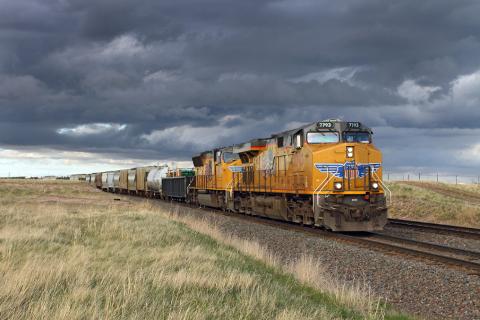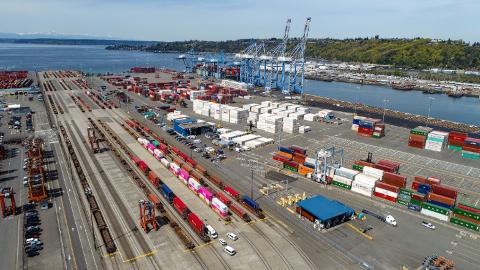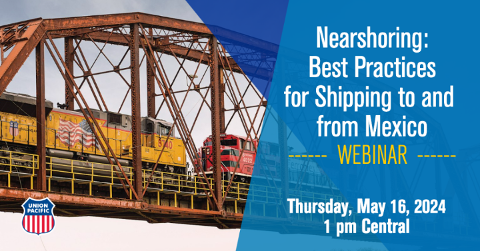Each November, the United States celebrates Native American Heritage Month, a time to pay tribute to the ancestry and traditions of the indigenous people of North America.
Union Pacific’s Council of Native American Heritage (CONAH) employee resource group (ERG) has a calendar of events planned to explore the culture and centuries old history of Native people. In addition to Native American Heritage Month, CONAH also held a cultural fair in honor of Indigenous Peoples’ Day.
“Celebrating Native American Heritage Month is important because it offers a subtle but impactful reminder of the contributions of Native Americans past, present and future,” said Haley Warner, CONAH President and Sales Manager for Union Pacific’s Marketing & Sales team. “Native American culture and history is so rich with meaning, yet not without tragedy. It is important to acknowledge the history of Native people, as told by them, and lift them up during this month. Native American Heritage Month gives a formal platform to lift up Native voices, acknowledge the history and appreciate the culture.”
ACE Conference
The ACE Conference is a joint event held by three Union Pacific ERGs: AERO (the Asian Employee Resource Organization), CONAH and EASE (a disability awareness and support ERG). Conference events include:
- Keynote speaker Ajit Dodani, Empathy Strategist, CEO & Founder of EmpathifyU. During Dodani’s more than 20 years as a C-Suite executive, he realized that the Empathy Strategy© he deployed was the real catalyst to sustainable organizational growth. Today, he empowers teams across the world to embrace “Empathy as a Superpower” to inspire a thriving workplace culture while achieving important business KPIs. In his keynote address, “Dial It Up!”, Dodani shares his story as an immigrant and discusses how “dialing it up” has been crucial to his personal and professional growth.
- Breakout sessions on Native dancing, preserving energy, and cooking.
- A culturally reflective lunch and networking opportunities.
CONAH Docuseries
Each month, Union Pacific employees are invited to watch a pre-selected documentary and attend a follow-up discussion hosted by an ERG. For November’s Diversity Docuseries session, CONAH will host a discussion of Winterfire season one, episodes 1-3. This documentary series shares stories related to Chickasaw history, culture, people and present-day tribal issues, including topics touching on removal, boarding schools and the revitalization of the Chickasaw language.
The Chickasaw are an Indigenous people whose traditional territory included northern Mississippi, northwestern and northern Alabama, western Tennessee and southwestern Kentucky. During the era of Indian removal in the 1830s, the United States government forced the Chikasaw to sell their traditional lands in the 1832 Treaty of Pontotoc Creek and move to “Indian Territory” in Oklahoma.
Today, the Chickasaw Nation in Oklahoma is the 13th-largest federally recognized tribe in the United States.
CONAH Book Club
Leading up to Indigenous Peoples’ Day and Native American Heritage Month, the CONAH Book Club read and discussed Killers of the Flower Moon: The Osage Murders and the Birth of the FBI. The 2017 nonfiction book about the Osage Indian murders was written by American journalist David Grann and has been adapted into a film directed by Martin Scorsese.
After large oil deposits were discovered beneath their land, the court awarded the Osage people the right to the profits. As they prepared to receive the wealth to which they were legally entitled, others in Osage County hatched a plot to murder them and remove what they saw as the “middleman.” The official number of victims was stated to be 20, but the book’s author suspects there could have been hundreds more.
Killers of the Flower Moon recounts the newly formed FBI's investigation of the murders and the eventual trial and conviction of the mastermind behind the plot.
In a statement about the movie, the Osage Nation Health System released the following statement:
“Trauma is not the end of our story. With intentional healing-centered efforts and knowledge, we manage it. Grounded in culture and tradition, Osage Nation Health System supports Osage tribal members through various wellness programs, including: Wahzhazhe Health Center, the Primary Residential Treatment Centers, the Osage Nation Counseling Center, Prevention, Community Health Representative, and Public Health Nursing.”
Cultural Fair
The CONAH Cultural Fair was held to connect Union Pacific employees with the Native community while also giving Native entrepreneurs, organizations, artists and leaders support and exposure.
- Vendors. Vendors included Native-owned Camille’s Bakery and sellers of jewelry, blankets, beads, beauty products and more.
- Community organizations. Representatives from local non-profit organizations the Bluebird Cultural Initiative and the Nebraska Urban Indian Health Coalition were also in attendance. The Bluebird Cultural Initiative provides programming to enrich the community’s understanding of the history and cultural traditions of Native American peoples of the Great Plains. The Nebraska Urban Indian Health Coalition provides community health care and services for urban American Indian and Alaska Native populations in eastern Nebraska and western Iowa.
- Hoop dancing. The Cultural Fair also featured a performance by a Native hoop dancer. Traditionally, medicine men performed hoop dances during healing ceremonies, with the hoops representing the circle of life. In the 1930s, Tony White Cloud from Jemez Pueblo, New Mexico, revolutionized the dance into a form of artistic expression and entertainment. Today he is considered the father of the modern hoop dance.
Over the years, dancers have included new and creative hoop designs, like animals and insects, as well as intricate footwork into their dances, while still respecting the traditional form. Since 1991, Native dancers have competed in the World Champion Hoop Dance Contest. World Championship competitors can use as few as 4 or as many as 50 hoops in their performances and are scored based on five skills: precision, timing/rhythm, showmanship, creativity and speed.
“The Cultural Fair demonstrated Union Pacific’s commitment to diversity and inclusion through creative and first-time experiences, especially for the Native American community and allies, which is a space we can continue to improve on,” Warner said. “It was a great way to share the positive work that CONAH is doing for our Native American employees and allies around cultural awareness, professional development and community impact.”
Why Celebrate Native American Heritage Month at Work?
Celebrating Native American Heritage Month at work creates a more inclusive environment for employees, strengthens bonds between coworkers and has a positive impact on employee engagement. According to Gallup, engaged employees have higher wellbeing, better retention, lower absenteeism and higher productivity.
“Holding events that represent Native American Heritage is an active celebration of the contributions that Native Americans are making today and will make in the future, not just the past. Native people, artists, community leaders, etc. are all around us making meaningful change in the community and upholding their culture,” Warner said. “This is our chance to celebrate and engage with them. Furthermore, holding events during Native American Heritage Month opens a door of connection that perhaps would not have happened another time. If CONAH can offer a chance to connect – we take it. An ERG like CONAH allows all employees – Native or non-Native, to be allies and learn, appreciate, and engage in community. Experiencing different cultures expands our minds and opens our perspectives.”
Learn More
To learn more about Native American Heritage Month, visit nativeamericanheritagemonth.gov. Or learn about diversity and inclusion and employee resource groups at Union Pacific.
For information about shipping freight by rail, answer a few questions and an expert will be in touch.
Related Articles
- How Does a Railroad Celebrate National Hispanic American Heritage Month?
- Celebrating National Hispanic American Heritage Month: A Q&A with Seven Transportation Leaders
- Celebrating AAPI Heritage Month: A Q&A with Four Transportation Leaders
- A History of Black Leaders in Transportation
- The Role of Women in Freight Shipping and Railroad History
- Celebrating Pride Month: A Q&A with Six Transportation Leaders
- The Impact of Black Inventors on the Railroad
- Asian American & Pacific Islander Leaders in Transportation History
- Celebrating Women’s History Month: A Q&A with Four Transportation Leaders
- Celebrating Black History Month: A Q&A with Six Transportation Leaders
- 12 Train Facts You Might Not Know
- Railroad History: How the Rail Industry Has Evolved in 160 Years
- Quiz: The Top Products Trains Ship to Mexico
- Quiz: The Top Products Trains Ship from Mexico to the United States









